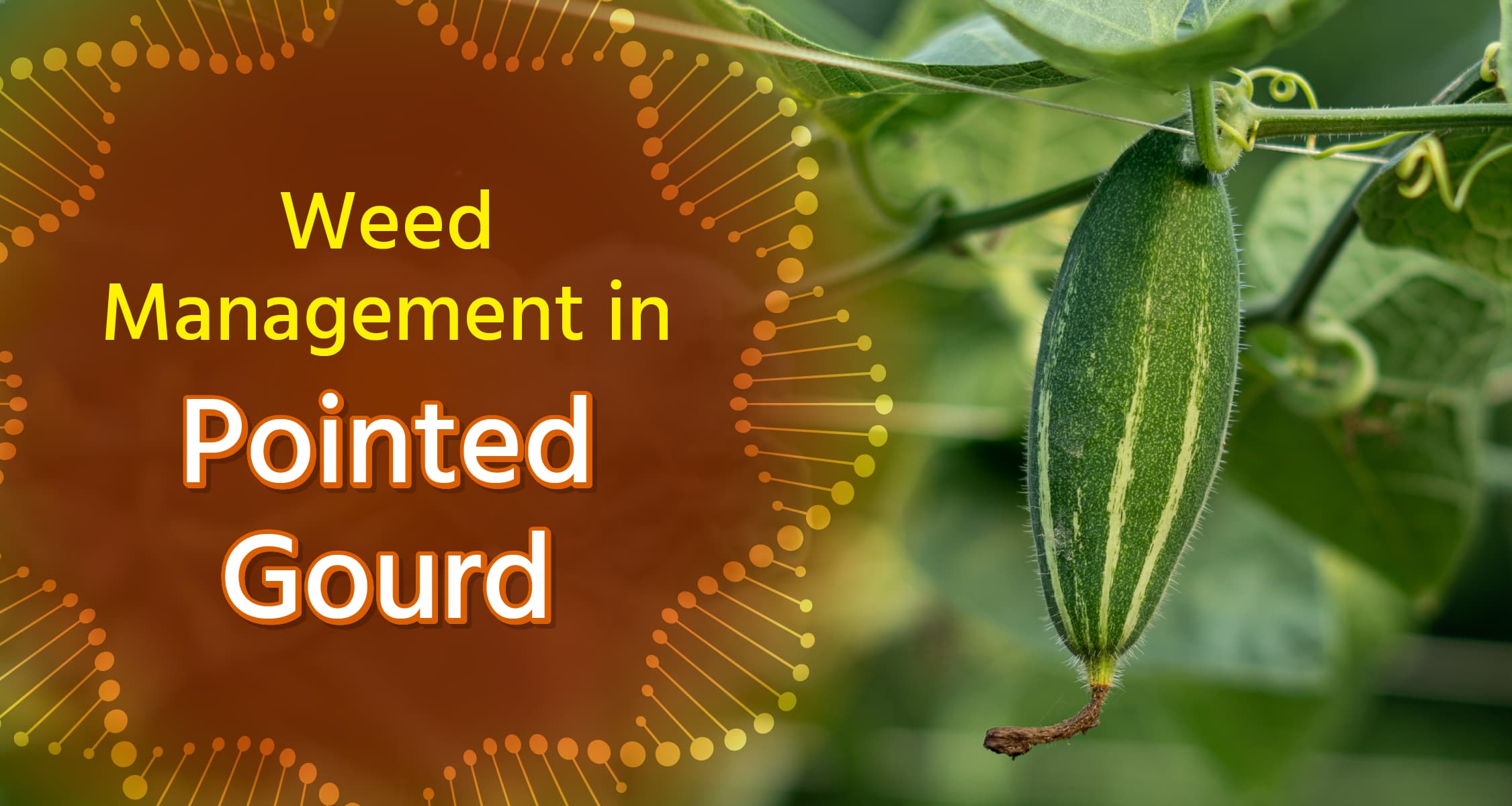Post Details
Weed Management in Pointed Gourd(Parwal)

Weed Management in Pointed Gourd(Parwal)
Weeds pose a significant threat to the yield and quality of pointed gourd (parwal) crops, as they absorb vital nutrients from the soil, potentially reducing crop yield by as much as 50%. Proper identification of weeds is essential, and agricultural professionals can offer guidance when problems arise in the field. Thankfully, there is a wide array of agricultural tools and inputs available to address weed issues effectively, offering solutions to minimize their impact on crop production. In this post, we will explore the damage caused by weeds, different methods of controlling them, and important considerations when using weedicide/herbicide.
Impact of Weeds on Pointed Gourd Crop
- Less Nutrient Availability: Weeds present in the fields absorb essential nutrients from the soil, resulting in inadequate nutrition for pointed gourd plants.
- Decreased Flower and Fruit Production: Overgrowth of weeds can diminish the quantity of flowers and fruits that grow on pointed gourd plants.
- Stunted Fruit Growth: Weeds have the potential to hinder the proper growth of the fruits, ultimately causing a reduction in fruit size.
- Increased Susceptibility to Diseases and Pests: Weeds serve as breeding grounds for various pests and fungi, which can subsequently infest the pointed gourd crop, leading to decreased yield and compromised quality.
- Decline in Crop Yield: Weeds inflict significant harm on primary crops, resulting in a decrease in crop yield. Consequently, farmers incur losses by selling less and low-quality produce.
- Increase in Expenditure: The utilization of herbicides/weedicides increases agricultural input expenses. Additionally, farmers resort to various pesticides and chemicals to combat pests and diseases, further adding up to the initial costs.
- Improper Supply: Given the adverse impact of weeds on crops, there's a potential risk of a pointed gourd shortage in the market. Such a scenario could result in farmers experiencing losses rather than profits. Moreover, the scarcity in supply may cause a surge in their prices.
Weed Control Techniques
Weeding
- Utilizing weeding is a significant approach in controlling weeds.
- The initial weeding can be carried out approximately 20 to 25 days after sowing.
- Subsequently, this process can be repeated as necessary.
- Weeding ensures optimal crop nourishment and aids in weed reduction.
Mulching
- Mulching represents an advanced weed control method in agriculture.
- It involves covering the soil around plants with materials such as plastic, straw, or leaves.
- Mulching inhibits weed germination and growth, providing prolonged protection for crops against weeds.
Weedicides/Herbicides
- Use 300 ml Oxyfluorfen 23.5% EC (Dow Goal) per acre of field.
- Use 150 gm of Metribuzin 70% WP (Dhanuka Barrier, Tata Rallis Metri) per acre of field.
- Use 600 ml Pendimethalin 38.7% CS (BASF Stomp Xtra) per acre of field.
- Use 300 ml Quizalofop Ethyl 5% EC (Dhanuka Targa Super) per acre of field.
- Do not spray the above-mentioned weedicides/herbicides on the plants or leaves of pointed gourd plants. Spray the chemicals in the middle of the beds.\
Factors to Consider While Applying Herbicides/Weedicides
- It is crucial to take into account several key factors when applying herbicides or weedicides.
- Adequate soil moisture is essential for ensuring adequate infiltration of the chemicals to reach the crop effectively during herbicide/weedicide application.
- Application of herbicides/weedicides is best done in the morning or evening.
- During spraying, it is important to use the correct quantity of herbicide/weedicide to avoid any adverse effects on the crop.
- Mixing herbicides with insecticides, pesticides, or fungicides should be avoided as it can decrease the efficacy of the herbicides.
What methods do you use to control weeds in pointed gourd crops? Share your answers with us in the comments. If you find the information provided in this post useful, don't forget to like and share it. For more information on weed control, follow the 'Weed Management' channel now. Also, to get proper advice on weed management from agri-experts, you can contact DeHaat's toll-free number - 1800-1036-110.
Frequently Asked Questions (FAQs)
Q: What is the process of weeding?
A: Weeding is a method employed to manage the growth of undesirable plants in a field. Tools such as spades, hoes, or harrows are utilized for this purpose. During weeding, weeds are either pulled out from the roots or cut near the soil surface. This process demands considerable time and manual effort, which is why it is typically preferred for smaller fields.
Q: What are the various approaches to managing weed growth?
A: Various approaches are carried out to manage weeds in agriculture. These encompass traditional techniques, tool-dependent methods, and chemical interventions such as weedicides or herbicides, alongside biological input options. Traditional practices incorporate strategies like crop rotation, intercropping, and mulching to suppress weed outbreaks. Tool-based methods involve manual removal and mowing of weeds. Chemical interventions utilize herbicides or weedicides for weed eradication. Additionally, organic inputs can also be utilized for weed control.
Q: How can weed growth be suppressed in fields?
A: Before planting the crop, conduct deep plowing to remove existing weeds. Utilize high-quality seeds for sowing and ensure thorough cleaning. Make sure that weed seeds are not present along with the crop seeds. Employ mulching techniques in the fields to further address this issue. Additionally, applying chemical weedicide/herbicide within two days after sowing can effectively manage weed growth.
Please login to continue

Get free advice from a crop doctor
